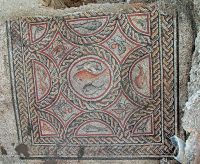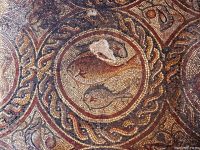Our server will be getting a MySQL and PHP upgrade this evening between 9:00PM and 3:00AM Mountain Standard Time. There could be some down time. If all goes well it’ll be no more than 15 minutes, so start burning them offerings to the faceless numen that regulate the dark forces of server upgrades.
Day: August 6, 2018
Third Lod mosaic found during construction of Lod mosaic museum
 The construction of the Shelby White and Leon Levy Lod Mosaic Center, a permanent home for one the largest and most intact (not to mention one of the most beautiful) Roman mosaic floors ever discovered, has resulted in the discovery of yet another exceptional mosaic floor. Israel Antiquities Authority (IAA) archaeologists unearthed the colorful depiction of fish, birds and plants in just one month of work.
The construction of the Shelby White and Leon Levy Lod Mosaic Center, a permanent home for one the largest and most intact (not to mention one of the most beautiful) Roman mosaic floors ever discovered, has resulted in the discovery of yet another exceptional mosaic floor. Israel Antiquities Authority (IAA) archaeologists unearthed the colorful depiction of fish, birds and plants in just one month of work.
This is the third one found at the site where the first mosaic floor was found in 1996. The second was discovered in late 2014. This embarrassment of archaeological and artistic riches was once part of a large luxury home dating to the early 4th century A.D. in the ancient city of Lydda which under the Roman Empire was a district capital and important center of trade. The first and largest mosaic covered the floor of the main reception room/triclinium. The second adorned an internal courtyard. The newly-discovered mosaic covered the floor of another smaller reception room/triclinium next to the one where the largest and first mosaic was found.
“The archaeological excavation that we carried out this month was relatively small, but contributed significantly to our understanding of the villa building,” said [excavation director Dr. Amir] Gorzalczany. “Thankfully, the main central panel of the mosaic was preserved. The figures, many similar to the figures in the earlier mosaics, comprise fish and winged creatures. A fairly similar mosaic was found in the past in Jerusalem, on the Mount Zion slopes. The Lod mosaics, however, do not depict any human figures that are present in the Mount Zion mosaic. It is quite probable that the same artist produced both mosaics, or that two artists worked from a similar design.”
“This type of mosaic is better known in the Western part of the Roman Empire,” Gorzalczany explained. “Also noteworthy are the rectangular marks that may denote the placing of the couches on which the participants of the banquet or feast reclined. These marks are common in similar villas and are an indication of the use of the space in the reception halls.”
 One corner of the mosaic was first spotted by archaeologists in 2014 at the time the second mosaic was discovered. Except for that one corner, the rest of the space was underneath a neighborhood parking lot and as the residents were none too keen to lose their handy spots, it took years of discussions before the mosaic could be excavated. Once the team was given the go-ahead, they had a brief window to excavate and salvage whatever they found before the property was returned to the residents.
One corner of the mosaic was first spotted by archaeologists in 2014 at the time the second mosaic was discovered. Except for that one corner, the rest of the space was underneath a neighborhood parking lot and as the residents were none too keen to lose their handy spots, it took years of discussions before the mosaic could be excavated. Once the team was given the go-ahead, they had a brief window to excavate and salvage whatever they found before the property was returned to the residents.
When the new Shelby White and Leon Levy Lod Mosaic Center opens, the first two mosaics will be displayed in situ exactly where they were found. This third one will also be on display, but not in its original location.
In this video you can see experts from the IAA salvage the mosaic, rolling it up like a carpet.